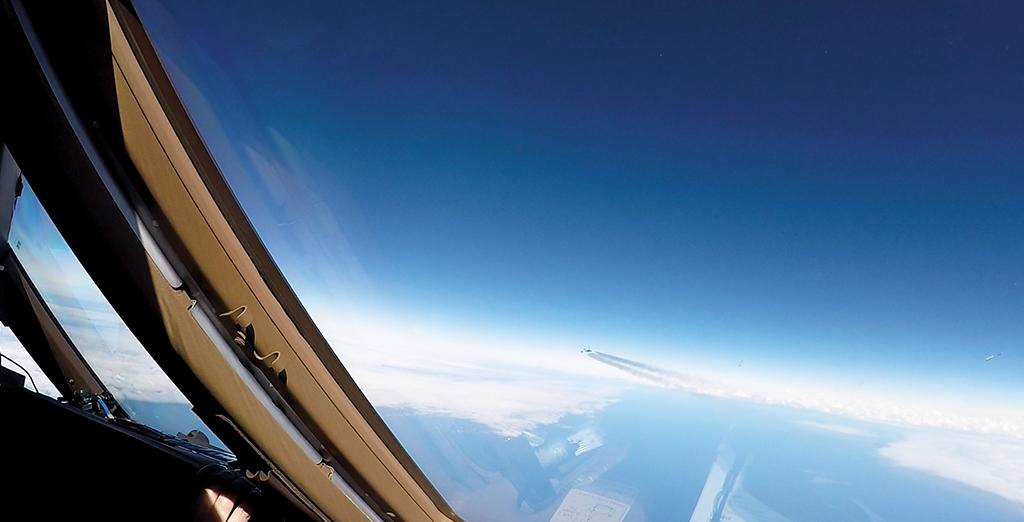
More than 20 years after researchers began studies of whether aircraft could save fuel by emulating the formation flying of birds, Boeing has validated new technology that could help make wake-surfing operationally practical.
Formation flight tests conducted with FedEx Express using two 777Fs confirm the potential for reducing fuel consumption by up to 10% by flying in the wingtip vortex of the lead aircraft, says the aircraft maker. The test, details of which have been disclosed for the first time, was conducted during Boeing’s 2018 ecoDemonstrator program using an aircraft leased from the cargo carrier.
- Boeing 777F EcoDemonstrator flown behind FedEx 777F
- Automated position-keeping showed fuel savings of up to 10%
The evaluation took place off the Washington-Oregon coast with the ecoDemonstrator flying in the wake of another FedEx 777F, which was undergoing customer acceptance testing prior to delivery. The test, which was the first by Boeing to investigate the potential efficiency benefits of wake-surfing using two airliners, followed similar flight trials by the U.S. Air Force, DARPA and NASA.
In November, Airbus also announced it plans to explore the fuel-saving phenomena under the fello’fly technology demonstrator project, which will involve formation flying with a pair of A350s in 2020. The following year, Airbus also hopes to start transatlantic fuel-saving operational trials in cooperation with airlines.
The Boeing-FedEx tests focused on validating the wake-prediction model used to assess the optimum cruise location for the in-trail aircraft, as well as the performance of the autopilot to maintain the correct computed position based on input from modified automatic dependent surveillance-broadcast (ADS-B) data link and traffic alert and collision avoidance (TCAS) systems.
Using precise positioning information and the wake-prediction model, the autopilot flies the aircraft in a zone where upwash inside the lead aircraft’s vortex increases the angle of attack on the trail aircraft’s wing. This rotates the lift vector and—because lift is an order of magnitude greater than drag—produces a significant reduction in drag for a small increase in lift.
Previous tests into wake-surfing such as NASA’s Autonomous Formation Flight program in the early 2000s, which used a pair of McDonnell Douglas F/A-18s, and the Air Force Research Laboratory’s Surfing Aircraft Vortices for Energy project, with paired Boeing C-17s in 2013, indicated a potential for fuel savings of 10-15%. In 2017, NASA also flew four wake-surfing test flights with two Gulfstream III variants to validate performance improvements from a modified autopilot in the trailing aircraft. The tests measured sustained fuel-flow reductions up to 8%, with brief periods of 10%.
“We took that technology and put it on a commercial aircraft,” says Doug Christensen, Boeing technical fellow and ecoDemonstrator program technical leader. “The system uses ADS-B (In) and ADS-B (Out), and it is really about the trailing aircraft knowing what the lead airplane is.
“Through ADS-B, it knows where the aircraft is, its weight and speed. Knowing all that, the trailing aircraft can position itself in the wake where it is safe and ride the vortex to take advantage of the drag reduction,” Christensen explained. “The system in real time predicts the strength and location of that vortex from the leading aircraft and positions itself accordingly.”
Jeanne Yu, director of technology integration and the ecoDemonstrator program, says: “The system relies on really robust and good wake-prediction models. Once you have that capability, you are able to place yourself in the right position. During the flight, they traversed the wake to test the model and validate whether they had predicted the sweet spot correctly, and they discovered they had it spot on.”
The work, which indicated savings of 5-10%, helps lay the foundation for future studies of wake-surfing and potential methods for proving its practical and safe application in commercial operations, Yu adds.
During the 2018 formation flight, which was performed at standard cruise speed and altitude, the two aircraft maintained 4,000-ft. separation—outside the predicted region of wake effects but still close enough to gain significant benefit for wake-surfing. The wake position was predicted by constant comparison of the location of the ecoDemonstrator and lead aircraft using ADS-B and the ship’s own data.
“The autopilot was configured to track a position relative to the wake,” says Boeing, who partnered with TCAS supplier ACSS on an updated system, which provided additional ADS-B In data to the ecoDemonstrator. “This allowed us to improve the wake prediction accuracy. Position relative to the wake and the lead aircraft was also presented to the pilots on a custom flight-test display,” adds the manufacturer.





